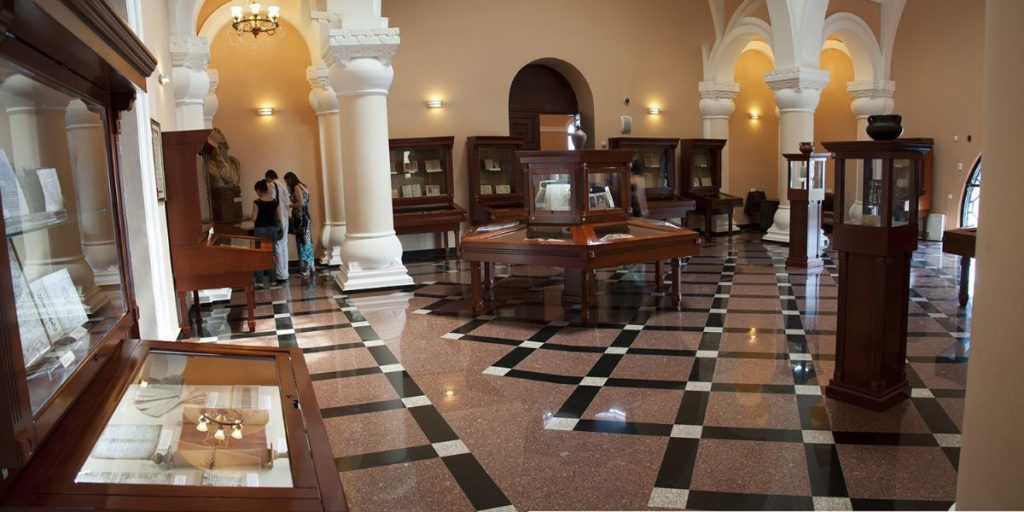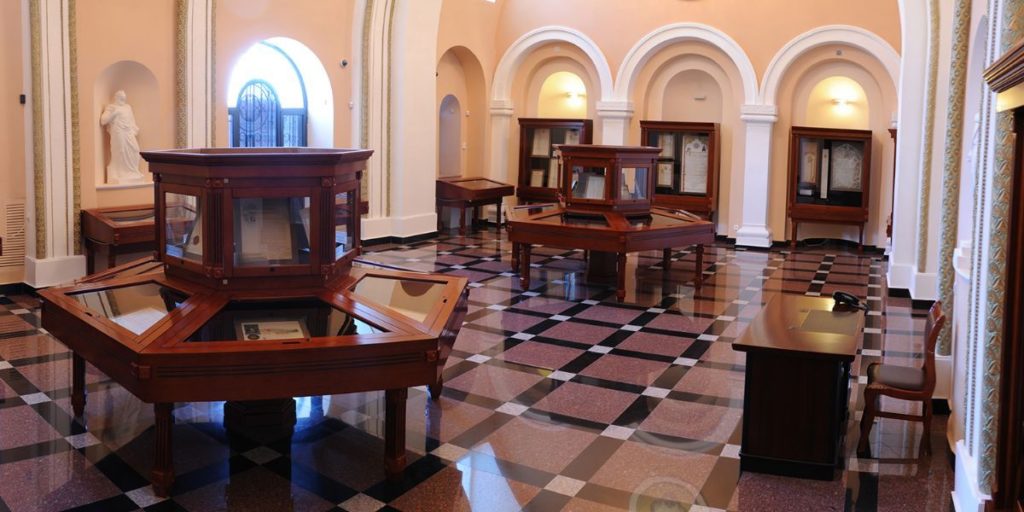

The Matenadaran’s museum complex is located in the institute’s old, original building. What was formerly a single exhibition hall now consists of fifteen halls in which thousands of temporary, changeable and exclusive exhibits are on display. Manuscript, fragments of manuscript, documents, old printed books, precious bindings, individual miniatures, and more are shown from the Matenadaran’s database of roughly 20,000 manuscripts.
The exhibition hall has been opened only in one hall in 1957 after the completion of the main Matenadaran building. The exhibition halls increased in number after the construction of the new Matenadaran facilities in 2011 (where the scientific departments moved), and the main building largely allocated to the exhibition halls, as well as offices, restoration laboratories, and strategically maintained repositories.
The exhibition of the Central hall is dedicated to the development of Armenian medieval sciences, literature, and arts throughout the centuries. It tracks Armenian culture since the creation of the Armenian alphabet by Mesrop Mashtots in 405 AD until the 18th century. It presents old Armenian translations and works of all spheres of medieval science and art (history, philosophy, exact sciences, cosmology, medicine, literature, etc.), donations, as well as medieval Armenian miniature painting and specimens of medieval bindings. The exhibition of this hall has been completed by the samples of the survived manuscripts from the Genocide.The Artsakh exhibition hall holds miniature works of the Artsakh School, with its artistic specificity and distinguishable features. Later, miniature painting from the Schools of Bardzr Haik (Upper Armenia), Cilician Armenia, the Crimea, Constantinople, and others will also be displayed.
In the manuscript collection hall of Mush and Karin are shown also survived manuscripts from Armenian other areas. More famous of those manuscripts are Msho Charentir (Homilies of Mush) (shown the first half of Homilies of Mush), Zeytun Gospel, miniature manuscripts of Cilician School (School of Toros Roslin). The exhibition also includes digital copies of numerous manuscripts shown by the electronic monitors on the wall.
In the hall of Vaspourakan’s manuscript collection visitors are introduced to the survived manuscripts which are basically belong to the Schools of Van and Vaspourakan. There are shown the Dashunahar Gospel, Hrashagorts Gospel, “The Book of Lamentations” of St. Gregory of Narek, the donated manuscripts to the Matenadaran by the president of the Republic of Armenia. There are shown near the hall through the photos the activities of Catholicos of All Armenians Gevorg V and the committees sent to Western Armenia.
In the Medieval Medicine exhibition hall visitors can admire with the manuscripts medical books which have not only historical and theoretical, but also modern and practical significance. In the Medieval Armenian Medicine laboratory of the Matenadaran, specialists use “cochineal” worms and aromatic plants and roots, that grow only in the Armenian Highland, to prepare wholesome “Royal Balm,” floral teas, and rejuvenating, anti-aging skin oils used by “noble women” in the Middle Ages. These items are unique souvenirs that are sold only in the Matenadaran; they are prepared according to medieval recipes. There are also displayed ingredients used to make natural dyes and the Holy Myrrh.
The Map’s hall displays maps reprinted from Medieval Armenian, Latin, Greek, Arabic and other manuscripts that depict about the ancient world and medieval geographical knowledge. The first map printed in Armenian is also shown (Amsterdam, 1695).
The exhibition of Archival valuable documents kept in the Matenadaran is devoted to the 100th anniversary of the Armenian Genocide in which are included samples exhibited the first time. The visitors have an opportunity to see the derelict property confiscation orders of Armenians, the photos of activities of Echmiadzin orphanage and Hovhannes Tumanyan, the registers of Armenian Prelacy of Adana, and the photos of Aintab battle, etc.
The Matenadaran’s archival documents collection was based on the Echmiadzin Catholicosate, and was later enriched by numerous donations. The number of documents now exceeds 500,000.
In the two halls of Old printed books are displayed Armenian and foreign valuable and rare books published in different countries and cities (Venice, Amsterdam, Constantinople, New Julfa, Paris, Marseille, Lvov, Madras, Rome, Moscow, Astrakhan, St. Petersburg, and elsewhere) during the 16th -18th centuries. The first Armenian books were printed in Venice in 1512-1513, by Hakop Meghapart.
In the frameworks of exhibitions of the 100th anniversary of the Armenian Genocide in the Virtual hall of the Matenadaran one can watch a documentary film about “Kemalist massacres” based on the Matenadaran’s archival documents.
In the four exhibition halls allocated for M. Saryan’s work’s visitors may see the master’s most famous works of art from his early works to his last oil painting “Fairy Tale”. The showrooms also display works from the Egyptian region, “Walking Woman,” “Night Landscape,” Saryan’s book illustrations (V. Bryusov’s “Anthology of Armenian Poetry,” 1916, etc.), and some items of Saryan’s personal belongings, as an Egyptian mask and so on.
The museum is open from Tuesday to Saturday: 10:00-17:50
Sunday, Monday, and holidays are free days.
The booking office is open from Tuesday to Saturday: 10:00-16:50. Tel: +374-10-513014
Groups of more than five persons must arrange visits in advance. Tel: +374 10 56 25 78.
Head of the Museum, Ph.D. in Arts, Yvette Tajarian +374-10-513045

